The first week of the New Year was quite good for oil bulls, because the agreement between OPEC and non-OPEC member countries to cut production continued to support the price of light crude. As a result, crude oil posted its fourth weekly gain in a row and hit a fresh peak of $55.24, climbing to the highest levels since Jul 2015. However, as it turned out, this improvement was very temporary and we saw a sharp decline on the same day. In the following days, oil bulls tried to come back to the top, but they failed and the main question is whether we will see the oil at fresh peaks in the coming weeks or not?
On one hand, we have the deal, which could reduce global supply by about 2% and affected positively investors’ sentiment in the recent weeks. According to this agreement, oil and gas condensate production were cut by 1.2 percent to 11.3 million bpd in the previous week in Russia. Without a doubt it was a positive event, but we can’t forget about output increases in Libya and Nigeria, which are both allowed to ramp up production as part of the OPEC deal. On top of that, Friday’s Baker Hughes report showed that the number of rigs in the U.S. rose by 4 to 529 in the previous week. It was the tenth straight weekly increase and a level not seen since Dec 2015. Is it possible that crude oil move any further in this environment? Let’s jump right into charts (charts courtesy of http://stockcharts.com) and try to find an answer to this question.
Crude Oil
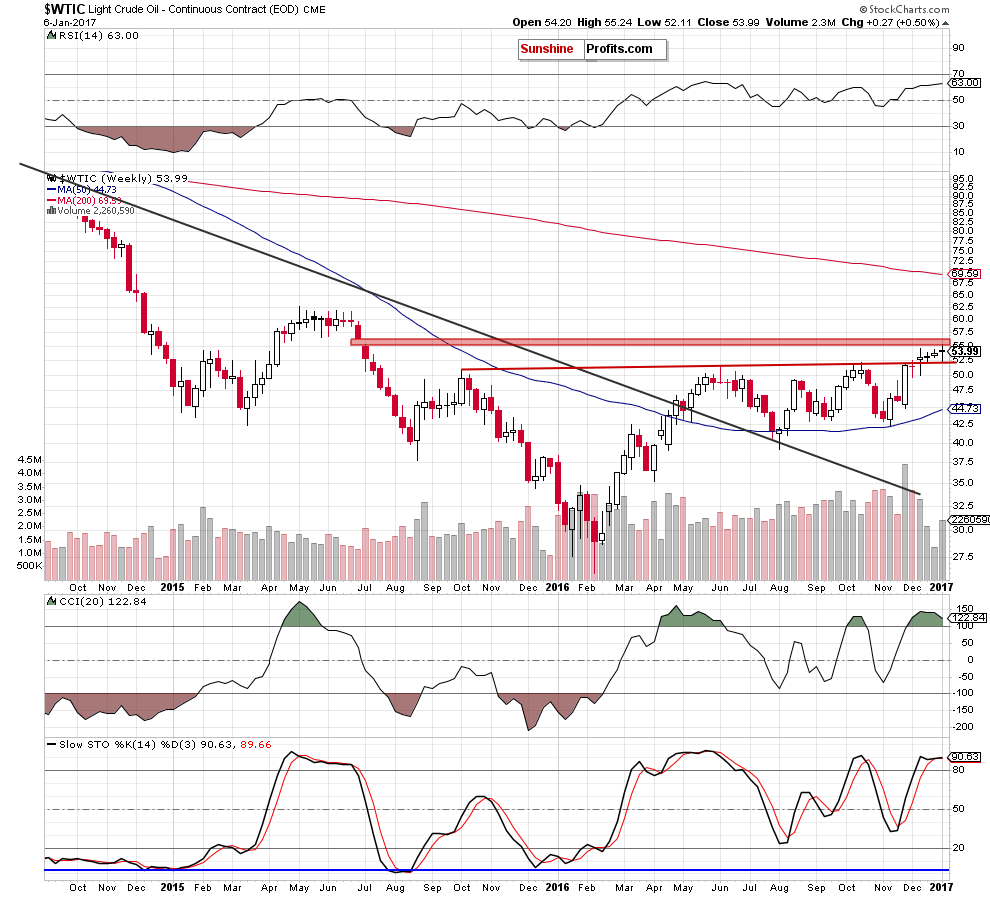
On the medium-term chart, we see that although crude oil closed another week above the previously-broken long-term red line, the commodity is still trading below the red gap (created at the beginning of Jul 2015), which serves as the nearest resistance. Additionally, the current position of the indicators (the CCI and Stochastic Oscillator are very close to generating sell signals) suggests that reversal and lower prices are just around the corner.
Are there any other technical factors that could encourage oil bears to act? Let’s examine the daily chart and find out.
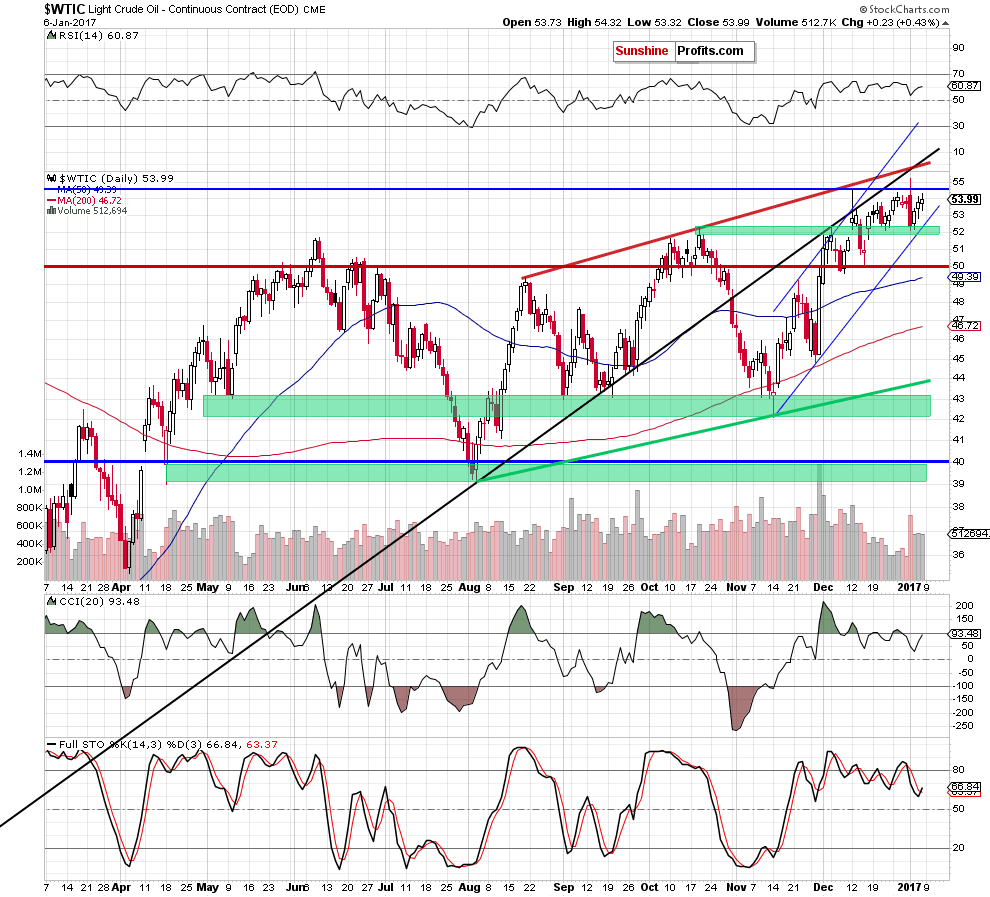
Looking at the daily chart, we see that crude oil extended gains in the previous week, but despite this improvement, light crude is still trading under the December and the January highs. This suggests that the space for gains may be limited – especially when we factor in the fact that the commodity remains well below the medium-term black resistance line and the red resistance line based on the previous highs.
Additionally, the invalidation of a breakout above the 2016 peak and its negative impact on the price is still in effect, supporting oil bears and lower prices in the near future.
If this is the case and we saw a correction of the recent rally, the initial downside target would be the lower border of the blue rising trend channel and the Jan lows (around $52.11-$52.42).
Summing up, the outlook for oil remains more bearish than bullish, however, it still doesn't justify opening short positions as light crude remains above the October peak and the lower border of the blue rising trend channel.
Having discussed the situation in crude oil, let’s examine the NYSE Arca Oil Index (XOI) to find out what the current outlook for oil stocks is.
Oil Stocks
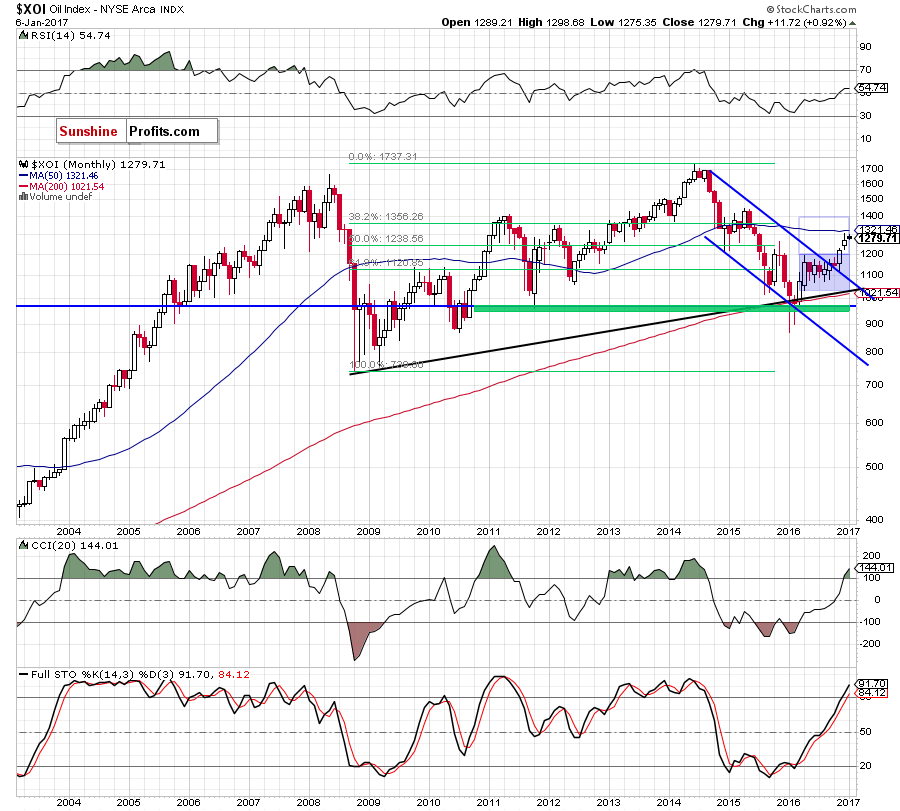
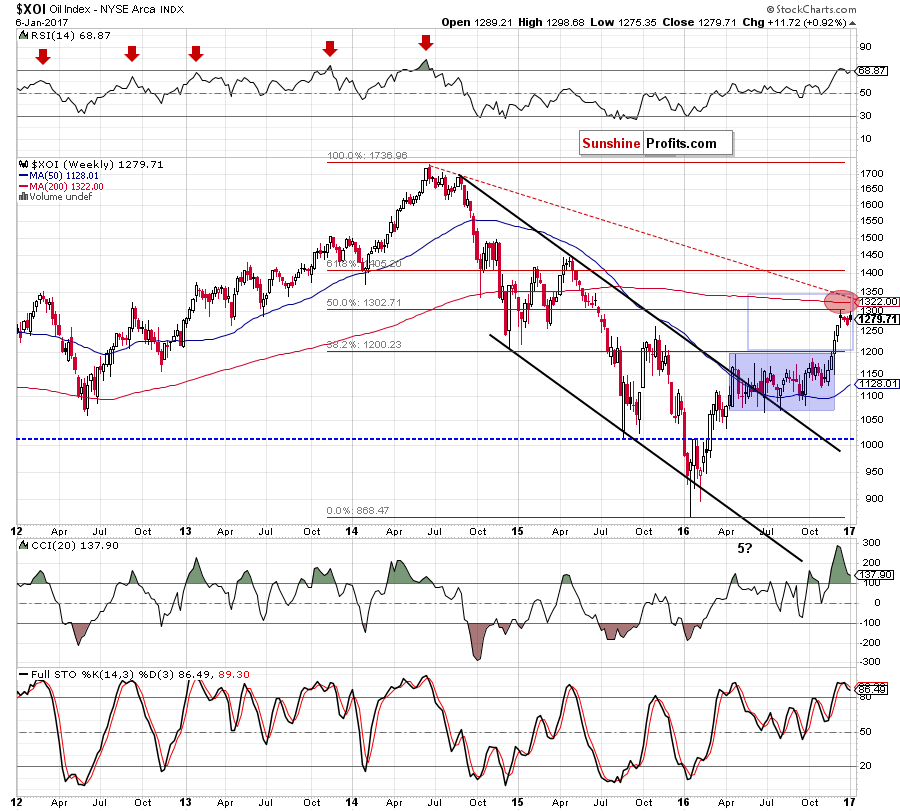
Quoting our previous Oil Investment Update:
(…) after several months in a blue consolidation, the XOI finally broke above the upper border of the formation, which is a bullish signal that suggests further improvement and (at least) a climb to the previously-broken 50-month moving average around 1,319.
What’s interesting, in this area is also a strong resistance zone (seen more clearly on the weekly chart (…) (around 1,300-1,345) (…) created by the long-term red dashed declining line (based on the Jun and Sep 2014 highs), the 200-week moving average and the 50% Fibonacci retracement (based on the 2014-2016 downward move). Additionally, in this area the size of an upward move will correspond to the height of the blue consolidation marked on the medium-term chart.
From today’s point of view, we see that the situation developed in line with the above scenario and oil stocks reached the lower border of our resistance area - the 50% Fibonacci retracement (based on the 2014-2016 downward moves). As you see, this resistance encouraged bears to act, which resulted in a pullback. Despite this drop, the XOI remains in the consolidation between the mid-Dec low and high (1,259-1,304) which makes the situation a bit unclear at the moment. Nevertheless, all indicators generated sell signals, which suggests that further deterioration in the coming weeks should not surprise us. Such price action would be however more likely and reliable is oil stocks dropped under 1,259 (the lower line of the mentioned consolidation).
How low could the XOI go in the coming weeks? In our, opinion, the initial downside target would be the barrier of 1,200 and the previously-broken Apr 2016 high of 1,194.
Summing up, the outlook for oil stocks is more bearish than bullish, however, further deterioration would be more likely and reliable after a drop below the mid-Dec low of 1,259. In this case, we’ll likely see further deterioration and a comeback to the barrier of 1,200 in the following weeks.
Ratio Analysis
Today, we start this section by focusing on the oil-to-oil stocks ratio. What can we infer from the chart below?
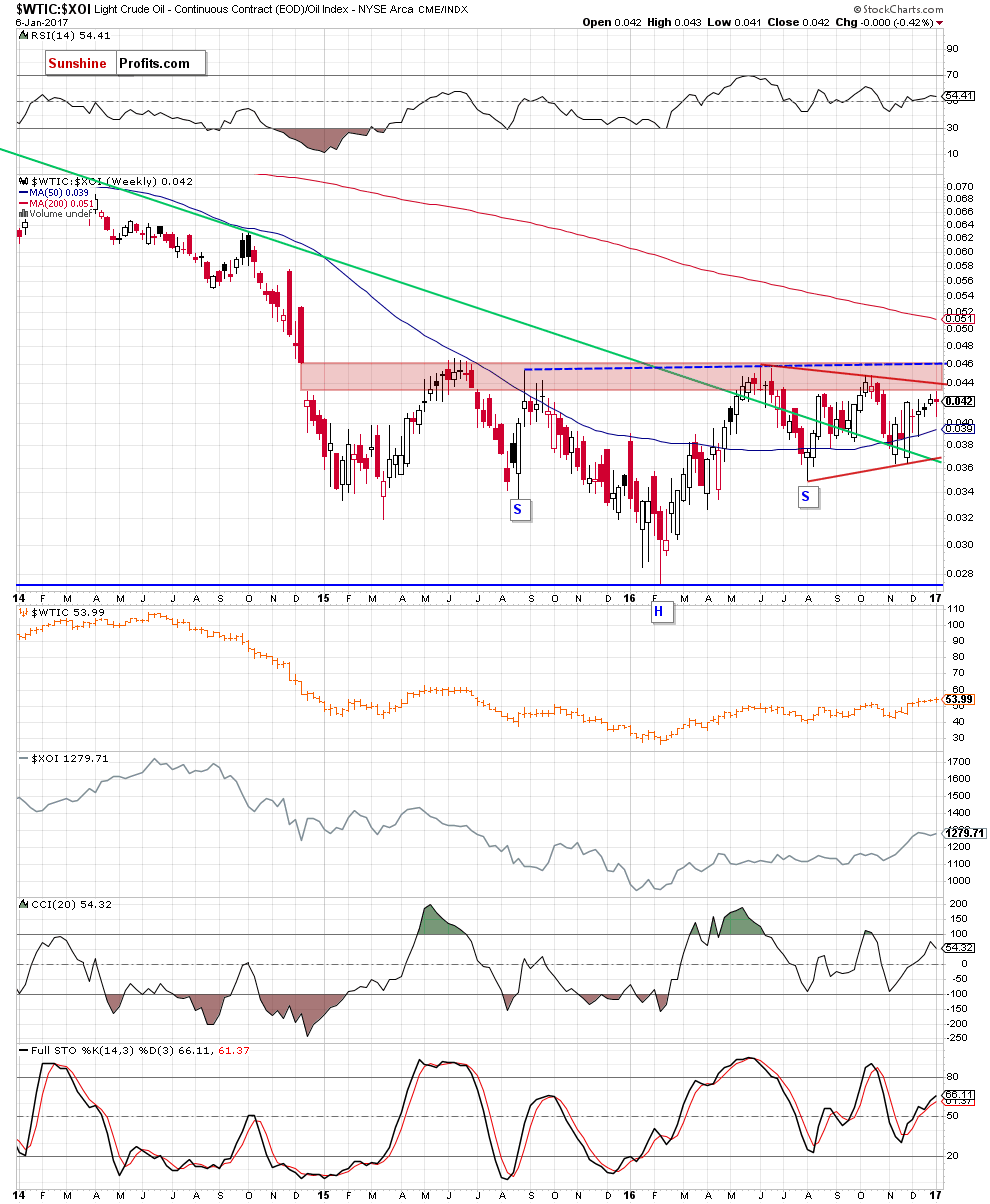
When we take a closer look at the weekly chart, we can notice that the ratio remains in the same area as a month ago, which means that our previous commentary on the medium-term situation is up-to-date also today:
(…) this area (based on the Dec 2014 gap) continues to keep gains in check. Therefore, we think that even if the ratio increases slightly from here, as long as there won’t be a breakout and a weekly closure above the upper border of the zone (which is currently reinforced by the neck line of a potential reverse head and shoulders formation) further rally is not likely to be seen and another reversal is very likely (not only in the case of ratio, but also in the case of crude oil as strong positive relationship remains in play).
Will the relationship between crude oil and precious metals confirm this pro bearish scenario? Let’s check the chart below and find out.
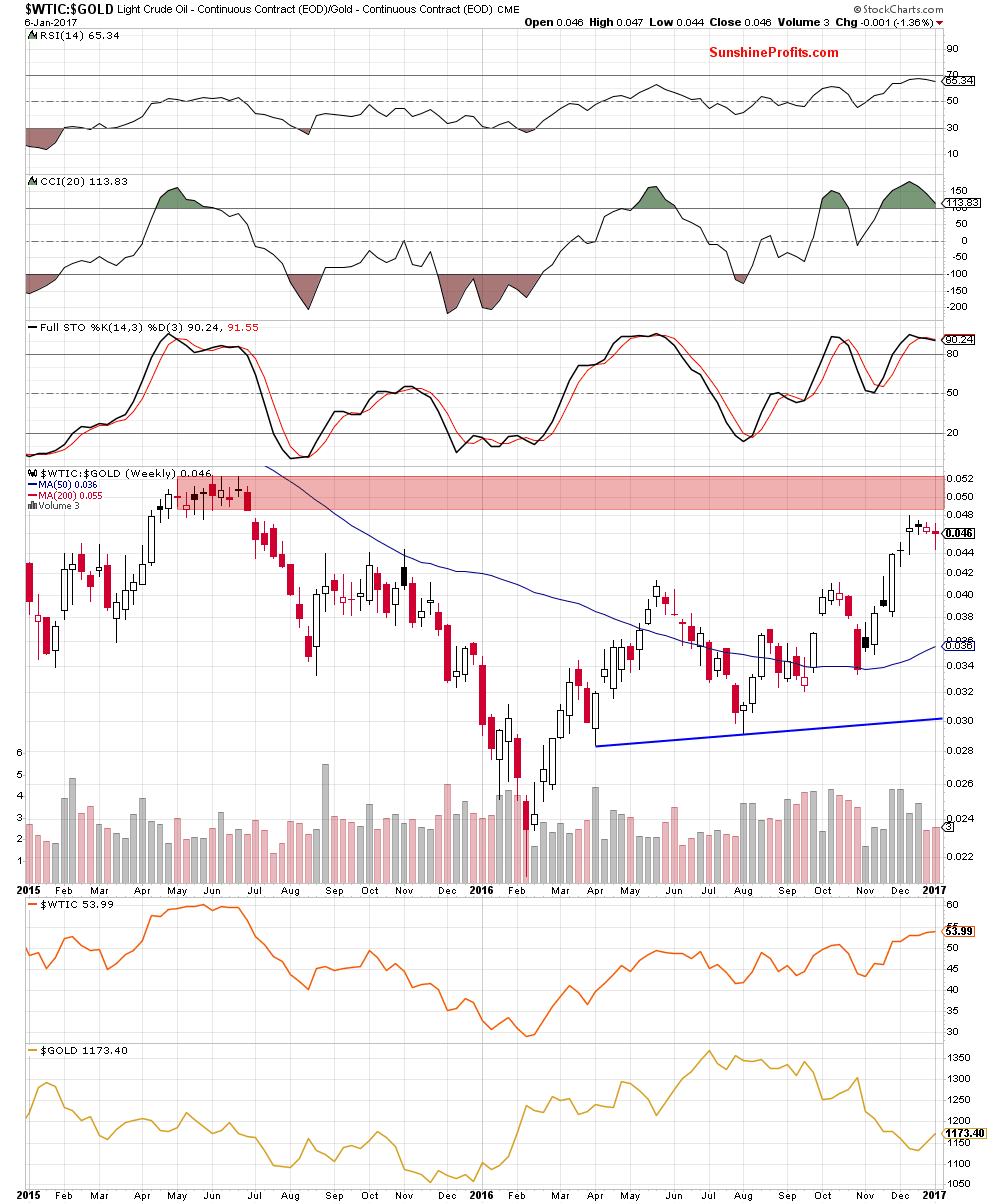
On the medium-term chart, we see that the ratio extended gains and reached the gap created at the beginning of Jul 2015, approaching at the same time to the lower border of the red zone, which is the key resistance at the moment. Additionally, the Stochastic Oscillator generated a sell signal, while the CCI is very close to doing the same, which increases the probability of further declines in the coming weeks. Nevertheless, such price action would be more reliable if the ratio declined below 0.0439 (the mid-Dec low).
Additionally, the pro bearish scenario is also supported by the very short-term picture.
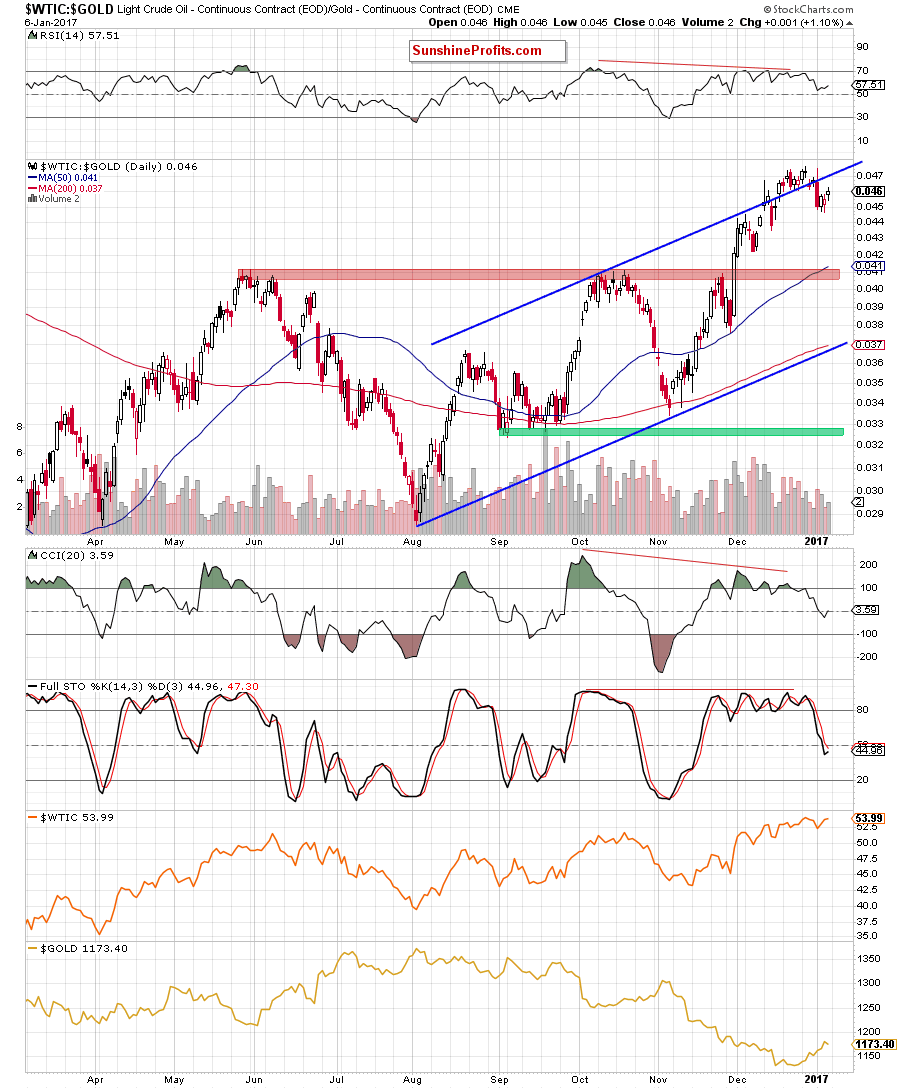
From this perspective, we see that the oil-to-gold ratio invalidated the earlier breakout above the upper border of the blue rising trend channel, which is a bearish development that suggests further deterioration – especially when we factor in sell signals generated by the indicators. Therefore, in our opinion, as long as there is no invalidation of the breakdown under this line, another move to the downside is very likely.
What does it mean for crude oil? Taking into account the positive correlation between the ratio and the black gold, a decline in the ratio will likely translate into lower price of light crude in the coming week.
Having said that, let’s take a closer look at the oil-to-silver ratio.
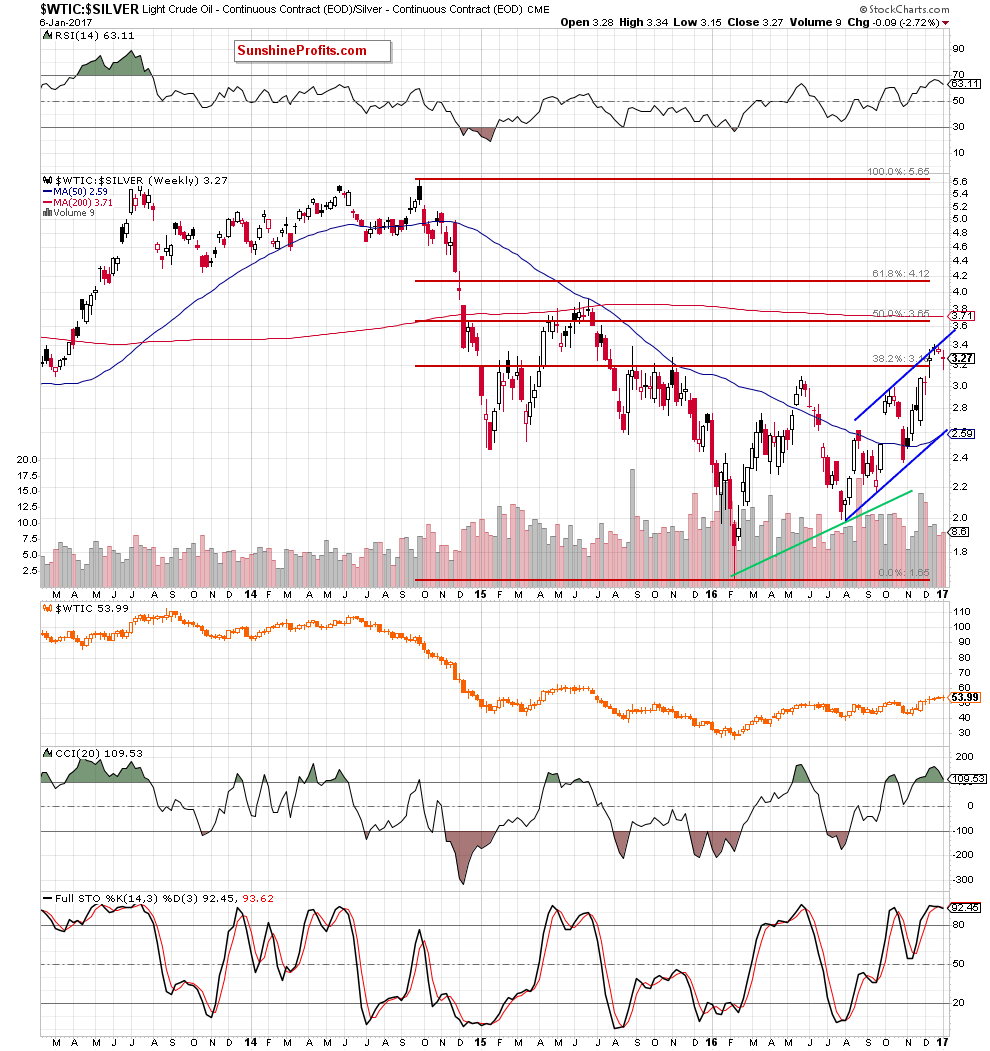
From the weekly perspective, we see that although the ratio extended losses and climbed above the 38.2% Fibonacci retracement, the upper line of the blue rising trend channel continues to keep gains in check, suggesting that the space for further rally may be limited and reversal in the coming week(s) should not surprise us – especially when we take into account the current position f the indicators – the Stochastic Oscillator generated a sell signal and the CCI is very close to doing the same.
This means that if the ratio moves lower from current levls and invalidates the earlier breakout above the Fibonacci retracement, we’ll likely also see an acceleration of decline in the case of crude oil.
Will the relation between oil and the general stock market give us more bearish signals? Le’s examine the charts below and find out.
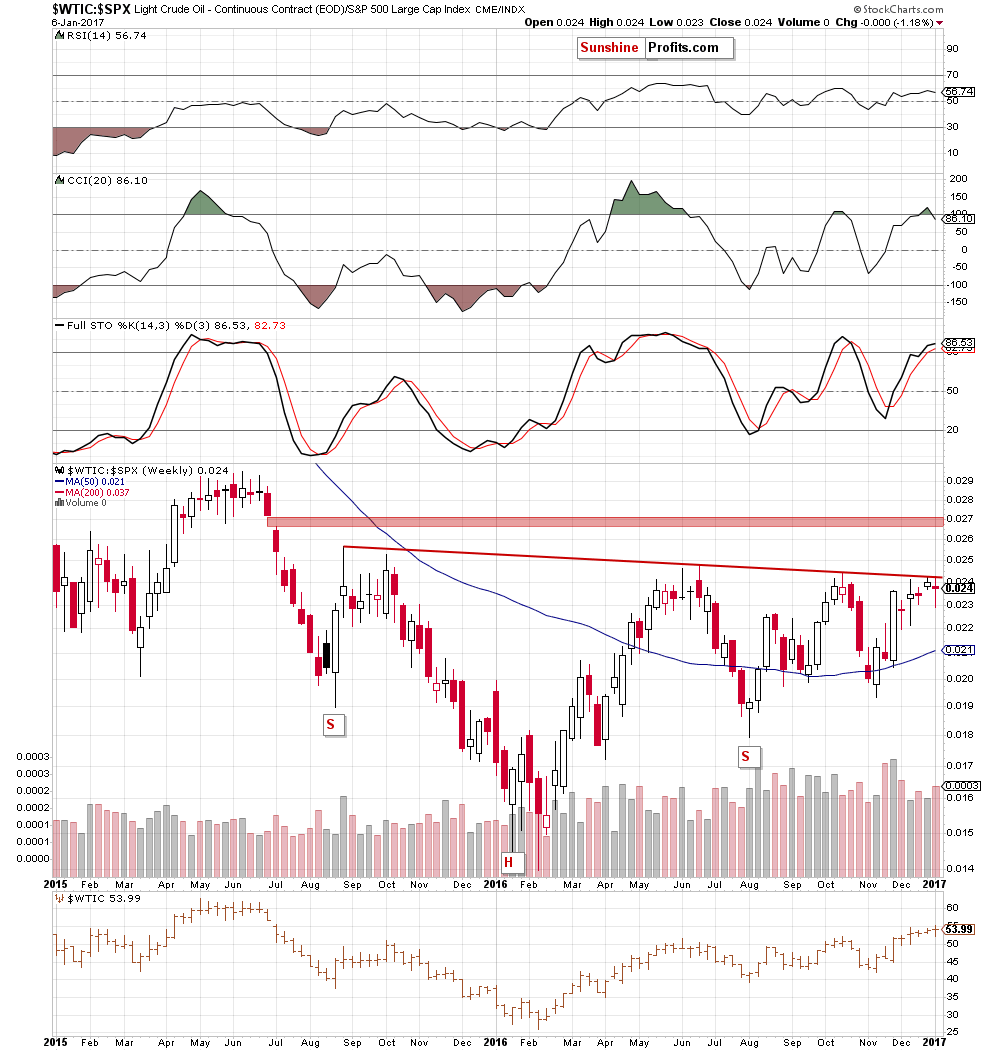
On the weekly chart, we see that although the ratio increased a bit in the recent weeks, the key red resistance line (based on the Aug 2015 and Jun 2016 highs) continues to keep gains in check. The Stochastic Oscillator climbed to its highest level since Oct 2016, while the CCI generated a sell signal, which together with the nearest resistance suggests that as long as there is no breakout above the red line another attempt to move lower (not only in the ratio but also in light crude) is very likely.
Non-USD Crude Oil Price
Know the situation for the above ratios, let’s move on to the non-USD (WTIC:UDN ratio) chart of crude oil. As a reminder, UDN is the symbol for the PowerShares DB US Dollar Index Bearish Fund, which moves in the exact opposite direction to the USD Index. Since the USD Index is a weighted average of the dollar's exchange rates with world's most important currencies, the WTIC:UDN ratio displays the value of crude oil priced in "other currencies".
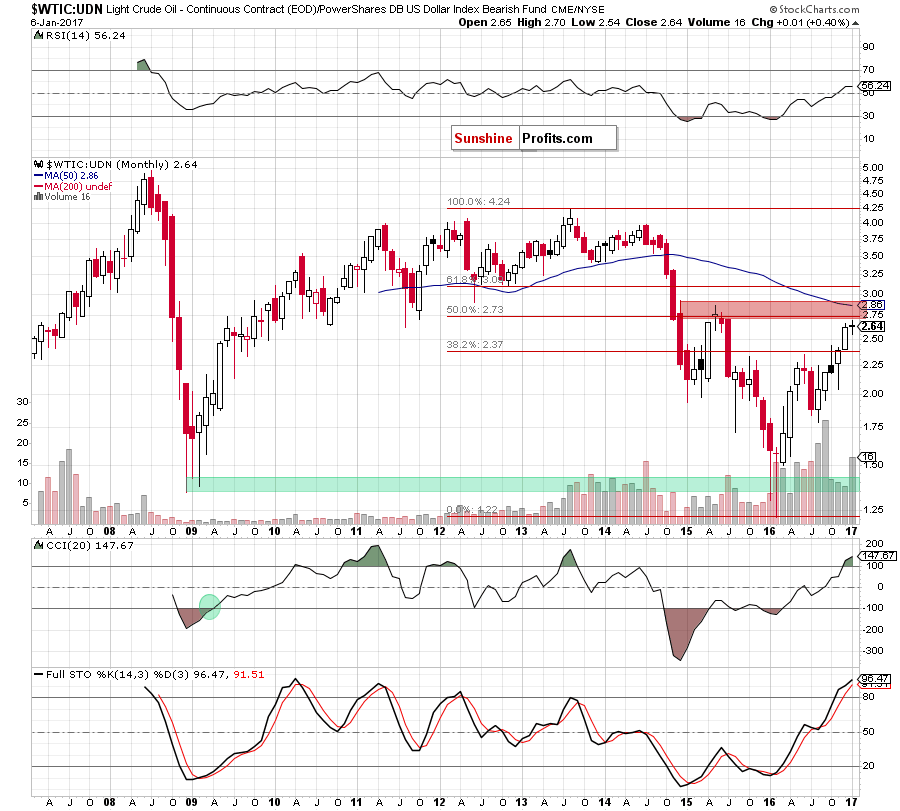
From the long-term perspective, we see that the ratio extended the rally and climbed to the red resistance zone (created by the 50% Fibonacci retracement, May, Jun and Jul highs and reinforced by the 50-month moving average), which suggests that we may see a pause or even a reversal in the coming month. This scenario is also reinforced by the current position of the indicators, which increased to the levels not seen since Aug 2013.
On top of that, the picture, which emerges from the medium-term chart also doesn’t bode well for higher values of the ratio and crude oil priced in U.S. dollars.
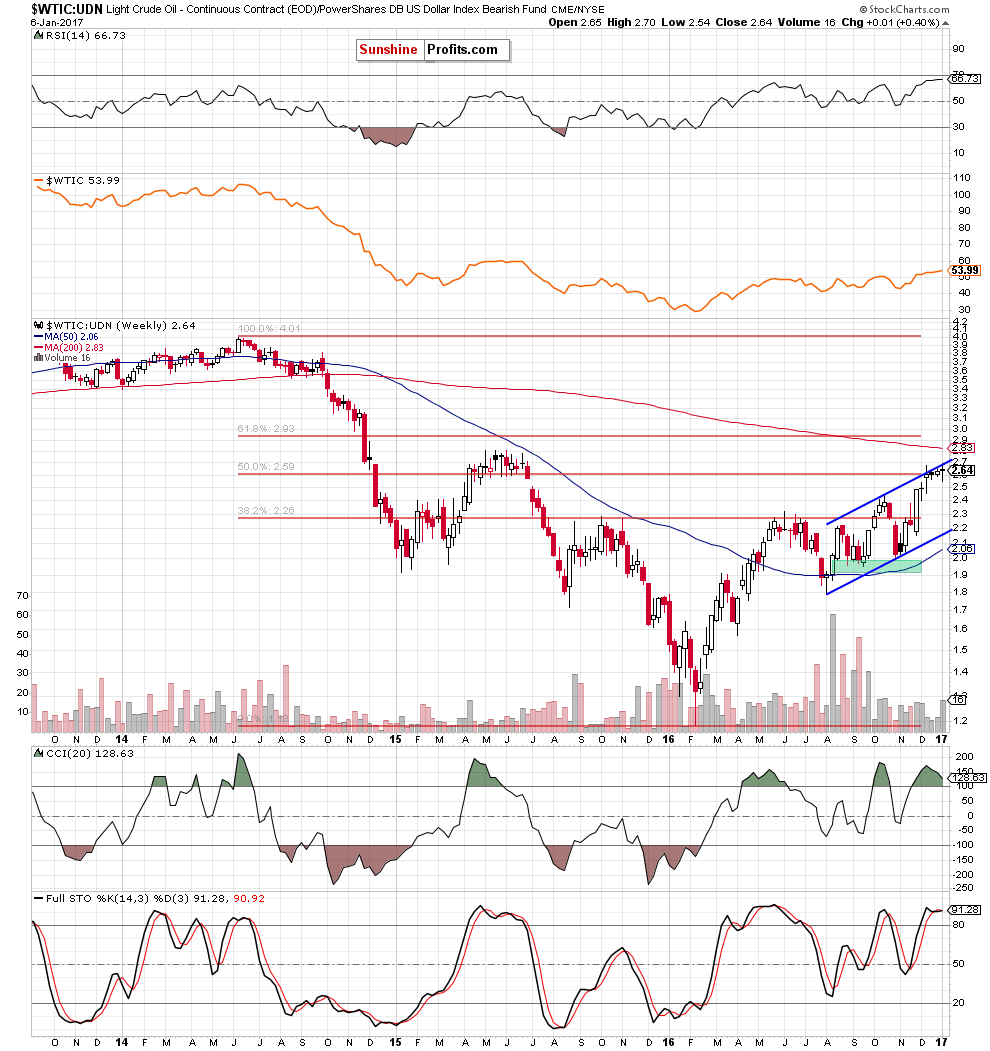
Looking at the weekly chart, we see that although the ratio moved higher in mid-Dec and increased above the 50% Fibonacci retracement, the upper border of the blue rising trend channel successfully stopped further improvement. Since then the ratio is consolidating slightly below this key resistance, which suggests that oil bulls may be not as strong as they were in Nov. If this is the case and indicators generated sell signals, the probability of a bigger decline would increase significantly – especially after an invalidation of the breakout above the Fibonacci retracement.
Scenarios
Just like a month ago, today’s Oil Investment Update includes scenarios of what could happen in the coming weeks. Naturally, we will continue to monitor the market in the coming days and if anything invalidates our long-term outlook we will send you an additional message.
- Bullish scenario
If crude oil extends gains and breaks above the Jan high, we’ll see a test of the black resistance line based on the Feb and Aug lows and the red resistance line based on the Aug and Oct highs (around $56.13-$56.51). If this resistance area is broken, the next upside target for oil bulls will be around $60-$62.58, where the 38.2% Fibonacci retracement (based on the entire 2011-2016 downward move), May and Jun 2015 highs are. - Bearish scenario
If the commodity closes the day under the lower border of the blue rising trend channel, we’ll see a re-test of the first support zone created by the Oct high, Dec and Jan lows (around $52.11-$52.49) or even a test of the barrier of $50. If it is broken, the next targets for oil bears will be: around $49 (the 38.2% Fibonacci retracement base on the Aug-Jan upward move and the Nov 22 high), the 200-day moving average (currently at $46.72), around $45.20 (the 61.8% Fibonacci retracement and late-Nov lows), the green support zone created by the May, Sep and early Nov lows (around $42.20-$43) and the barrier of $40.
Summary
As we mentioned earlier, the outlook for the black gold remains more bearish than bullish as crude oil is still trading under the key resistance lines (the black line based on the Feb and Aug lows and the red resistance line based on Aug and Oct high, which successfully stopped oil bulls several times in the previous weeks. Additionally, the oil-to-gold ratio invalidated the earlier breakout above the upper border of the blue rising trend channel, while the oil-to-silver and the WTIC:UDN ratios have problems with breakouts above the upper lines of their trend channels. On top of that, the current position of the indicators (not only in the case of crude oil, but also in the case of all our above-mentioned ratios) suggests that the space for gains may be limited and reversal in near future is very likely. If this is the case, we’ll see a realization of the bearish scenario in the coming week(s).
Very short-term outlook: bearish
Short-term outlook: mixed with bearish bias
MT outlook: mixed with bearish bias
LT outlook: mixed
This completes this month’s Oil Investment Update. Our next Oil Investment Update is scheduled for Monday, Feb 6, 2017. Oil Trading Alerts subscribers will additionally receive similar but shorter alerts on a daily basis (or more than once a day when the situation requires it). You – Oil Investment Updates subscribers – will receive short Investment Alert messages should the outlook for the medium or long term change before the next Update is posted.
Thank you.
Nadia Simmons
Forex & Oil Trading Strategist
Oil Investment Updates
Oil Trading Alerts



